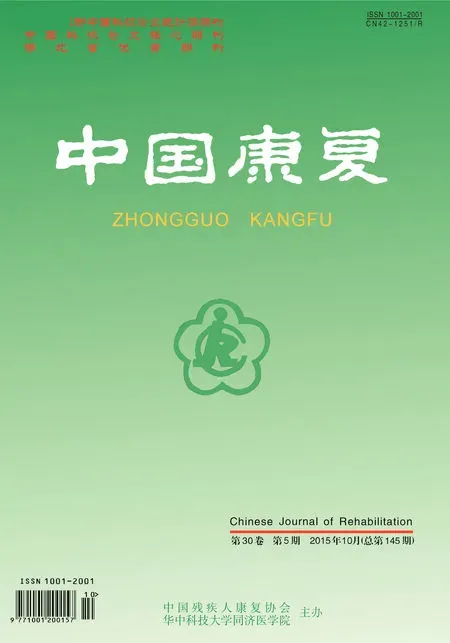脑卒中后认知功能障碍筛查量表的研究进展
洪文军,陶静,2,陈立典
随着人口老龄化,每年全世界范围内有1.5亿人发生脑血管意外[1],其中40%~77%的脑卒中患者能够存活1年左右,但幸存者会伴随多种不同程度的残障[2]。尽管脑卒中后认知功能障碍(Post Stroke Cognitive Impairment,PSCI)的发生率在不同研究中存在差异,但是脑卒中是认知功能障碍的一个主要原因已经成为一个共识[3-4]。认知功能检测的方法很多,目前以量表评估结合临床客观评估手段(如脑功能成像、运动想象、生物力学分析等)为主,而对于急性或亚急性期脑卒中患者,快速筛查量表因其可在床边进行、操作简便以及易被患者接受等特点是指导一线医务工作者早期诊疗认知功能障碍患者最重要的工具[5]。快速筛查量表应具有时间效应、认知模块涵盖范围广且针对性强的特点,这对于康复工作者对急性或亚急性期脑卒中患者采用适当的诊断和治疗方案是极其关键的。
1 信效度研究概况
现阶段,用于PSCI的筛查工具主要有简易智能精神状态检查量表(Mini-Mental State Examination,MMSE)、蒙特利尔认知评估量表(Montreal Cognitive Assessment,MoCA)、神经行为认知状态测试(Neurobehavioral Cognitive Status Examination,NCSE)、Addenbrooke改良认知评估量表(Addenbrooke's Cognitive Examination-Revised,ACE-R)、洛文斯顿作业疗法认知成套测验(Loewenstein Occupational Therapy Cognitive Assessment,LOTCA)、老年人认知功能下降知情者问卷(Informant Questionair on Cognitive Decline in the Elderly,IQCODE)等[6-8]。尽管这些量表并非PSCI专用筛查工具,但仍然被广泛用于康复日常诊疗工作以及研究中。本文着重介绍上述量表的信效度研究进展。
1.1 简易智能精神状态检查量表 MMSE由Folstein[9]针对精神疾病患者的认知损伤编制而成,是目前世界上最常用的认知功能障碍评定工具之一,测试包括时间定向、地点定向、记忆力、注意力和计算力、回忆能力、语言能力5个方面,整个量表共11项题目,用时约需5~10min。研究证实MMSE具有良好的信度和效度,MMSE与韦氏言语测试的相关系数r=0.776,与韦氏操作测试的相关系数r=0.660,24h同一评定员和两名评定员的重测信度相关系数分别为0.887和0.827[9]。国内主要有北京版、上海版、广东话版和哈萨克文版等版本,研究显示各个中文版本的MMSE具有与原版较为一致的信效度特征[10-11]。虽然MMSE目前被广泛应用于脑卒中患者的认知筛查,但值得注意的是多项研究发现MMSE除了其自身无法区分轻度认知功能障碍以及对教育水平低的老年人敏感度偏低等局限之外[12],对于脑卒后特定认知领域筛查具有相应的限制。如MMSE对于急性脑卒中的相关认知领域缺乏足够的敏感性[13],特别是对视知觉、抽象推理和执行功能[13],且具有较为明显的地板效应[14]。
1.2 蒙特利尔认知评估量表 MoCA由Nasreddine针对轻度认知功能障碍(mild cognitive impairment,MCI)最常受损的认知领域研制而成,测试涵盖视空间与执行功能、命名、记忆、注意、语言、抽象、延迟回忆和定向,需时约10min[15]。Nasreddine等[15]的研究显示MoCA筛查MCI的灵敏性为90%,发现轻度阿尔兹海默病的灵敏性为100%,特异性为87%,重测信度相关系数为0.92,内部一致性克朗巴赫系数(Cronbach α)为0.83,与MMSE的相关系数为r=0.87,表明MoCA具有良好的信度和效度。多项针对脑卒中人群的信效度研究表明MoCA具有较好的心理测量学特征,可用于PSCI评估[16-18]。目前,国内编译了北京版、香港版、台湾版和长沙版等多个版本MoCA,均显示信效度较好[19-21]。然而,近阶段的研究结果亦发现MoCA特异性跨度较大[17],尤其对于PSCI,存在高敏感性低特异性的现象[22-23],需要结合其他筛查量表以弥补这一缺陷。
1.3 神经行为认知状态测试 NCSE是Kiernan等[24]参考MMSE及长谷川痴呆量表(Hascgawa's Dementia Scale,HDS)等编制而成,测试涵盖了意识、定向、注意、语言、空间结构、记忆、计算和推理判断,除记忆外,其余项目均需先进行甄别测试,筛查不合格的患者进行等级测试,测试结果以模块得分显示各认知领域受损情况,用时约需10~20min。研究证实NCSE的分测验与各标准神经心理测试呈高度相关[25],因采用定量的等级测试,NCSE对认知功能障碍较为敏感[26]。中文版NCSE量表由香港麦理浩康复中心作业治疗室修订,许涛等[27]对中文版NCSE的信效度特征进行检验,结果显示绝大部分项目重测信度系数r>0.7,灵敏性为93.5%,特异性为65%,语言项目与中国康复研究中心失语症检测(Chinese rehabilitation research center aphasia examination,CRRCAE)以及记忆项目与Rivermead行为记忆评定(Rivermead Behavioural Memory Test,RBMT)的相关系数均>0.7,表明其中文版NCSE具有较好的效标关联效度。然而研究亦证实NCSE具有假阴性率偏高,即敏感性偏低的缺陷[28-29],亦有研究显示NCSE的假阳性率存在人种间的差异[30]。
1.4 Addenbrooke改良认知评估量表 ACE-R根据ACE修订而成,主要适用于不同类型的痴呆患者,如阿尔兹海默病、 额颞叶痴呆和路易小体痴呆等。量表涵盖5个认知领域:定向力或注意力、记忆力、语言流畅性、语言以及视空间能力[31]。总分为100分,得分为5个分测试之和,得分越高,反映受试者的认知功能越好。Mioshi等[31]通过信效度检验揭示ACE-R具有良好的信度(alpha coefficient=0.8),与临床痴呆量表(Clinical Dementia Scale,CDS)的相关系数r=-0.321,分界值取88时敏感性为0.94,特异性为0.89,分界值取82时敏感性为0.82,特异性1.0。Gaber等[32]将ACE-R对59例脑卒中患者进行失语症检验,结果显示当语言模块分界值取22/26分时,其特异性和敏感性分别为100%和83.1%,而当分界值取16/26分时,特异性和敏感性分别为88.2%和100%,表明ACE-R的敏感性和特异性较为理想。然而,Morris等[33]对101例急性脑卒中患者进行信效度检验,结果却显示ACE-R并不适合急性期脑卒中患者的整体认知功能筛查。此外,ACE-R对于脑卒中患者非记忆认知模块损伤存在敏感较低的局限[34]。
1.5 洛文斯顿作业疗法认知成套测验 LOTCA是一项针对脑损伤后认知功能障碍的评估工具,测试包括定向、知觉、视运动组织和思维操作4个方面,共20项检查,涵盖定向力、视觉失认、命名障碍、空间失认、失用、单侧空间忽略、视空间组织推理、颜色失认、失写、思维运作和注意等认知领域,完成测试用时约需30min[35]。Katz等[35]对20名脑创伤患者和28名脑卒中患者进行信效度研究,结果显示各分测试的评定者间信度相关系数为0.82~0.97,定向、知觉、视运动组织和思维操作各分测验的内在一致性信度系数为0.85,表明其信度、效度良好。中国康复研究中心于1998年引进该量表,国内已完成第2版LOTCA引进和汉化。不可忽视的是,研究显示LOTCA对于PSCI存在一定的局限性,如Su等[36]在探查脑梗死和脑出血的之间的感知差异时发现,LOTCA无法保证其评定效果,需联合Rivermead知觉评定等量表以改善,且其评分系统需修正,以减少评分的主观性。
1.6 老年人认知功能下降知情者问卷 IQCODE由Jorm编制,主要调查老年受试者近十年的认知功能表现,该量表原有26个测试条目,每个条目有5个选项。Jorm等[37]对IQCODE进行改编,制定了16个测试条目的简化版IQCODE,通过研究证实原版与简化版的相关性为0.98,两个版本与MMSE的相关系数分别为0.58和0.68,且ROC曲线(Receiver operating characteristic curve)的曲线下面积(Area Under The Curve,AUC)均为0.8,表明其具有较好的敏感性和特异性。虽然该量表被广泛应用于脑卒中患者,但研究发现其对PSCI的筛查存在局限:如Srikanth等[38]对79例发病1年后首次脑卒中患者验证简化版IQCODE的效度,结果显示其对首发脑卒中后非痴呆性认知障碍(cognitive impairment not dementia,CIND)和非失语性认知障碍的敏感性偏低,需要结合MMSE提高其筛查的敏感性。
2 小结
目前,认知评估工具、手段和平台越来越多元化,有量表评估、脑功能影像学检查、理化指标检查等,并实现了这些检查方法与计算机综合互联网平台分享技术相结合。对于急性期或亚急性期脑卒中患者而言,认知筛查量表具有明确的时间效应,便于在床边进行,受时间和场地的影响较其他手段小,可以根据患者状况实时进行,便于对患者的认知能力进行状态横向以及时间纵向的对比,对后续的诊断和治疗具有指导性意义。现阶段用于脑卒中患者的认知筛查量表种类分为专项认知筛查和整体认知筛查,以整体认知筛查量表应用最为广泛,如MMSE、MoCA、NCSE、ACE-R、LOTCA、IQCODE等。
虽然上述量表被广泛应用于筛查脑卒中患者的认知状态,但这些量表大多最初设计用于评估由精神障碍、老龄化等所致的MCI和痴呆等,因而除了量表评估本身不可避免的主观性偏差之外,其应用于脑卒中患者人群所存在的潜在局限性不可忽视。因为痴呆以及其他疾病导致的认知损害与PSCI的特点有鲜明的差异,尤为显著地是通常PSCI包括失语症、视野缺损、空间忽略、失用症、失读症以及失写症等,而现有常用筛查量表往往不能评估上述功能。此外,这些量表评估脑卒中患者的结果可能存在被上述障碍相互干扰的风险,如这些量表需要受试者拥有最基本的语言功能,而失语症患者则无法完成记忆等其他认知领域的评估,再如视觉忽略患者因忽略自身和或事物一侧而无法完成或干扰这些测试。因而,这些量表完成或未完成的评估结果往往失去了原有意义。值得引起注意的是,中文版本量表在引进和修订的过程中大多忽视了内容效度验证,以致部分条目与原量表条目的测试意义存在偏颇。目前上述量表,尤其是翻译修订后的中文版本总体上对于脑卒中人群的信效度研究相对偏少,而现有研究提示上述量表筛查PSCI时存在敏感性与特异性不平衡的现象,往往表现为敏感性较好而特异性偏低,致使单一量表量表无法独立完成对脑卒中患者进行筛查,需要结合其他量表以降低假阳性率与假阴性率,从而提高筛查效果。此外,现有研究的诊断纳入排除标准、受试者人数以及受试者发病时间不同,目前也没有一个如何选择评估工具的明确标准,临床上康复医师和治疗师往往选择自己所掌握的、熟悉的筛查量表,故严格意义上尚缺乏PSCI筛查的统一标准。综上所述,对于脑卒中后认知功能障碍筛查量表仍需进行深入细致的研究,收集积累更为全面的资料和数据,尤其应开展针对脑卒中人群的信效度研究以便进一步探索和制定用于PSCI的最佳特定筛查工具,为脑卒中患者康复进一步的诊断治疗提供正确的方向。
[1] Murray CJ,Lopez AD. Mortality by cause for eight regions of the world: Global Burden of Disease Study[J]. Lancet,1997,349(9061):1269-1276.
[2] Kaste M,Fogelholm R,Rissanen A. Economic burden of stroke and the evaluation of new therapies[J]. Public Health,1998,112(2):103-112.
[3] Henon H,Durieu I,Guerouaou D,et al. Poststroke dementia: incidence and relationship to prestroke cognitive decline[J]. Neurology,2001,57(7):1216-1222.
[4] Jaillard A,Naegele B,Trabucco-Miguel S,et al. Hidden Dysfunctioning in Subacute Stroke[J]. Stroke,2009,40(7):2473-2479.
[5] Braaten AJ,Parsons TD,Mccue R,et al. Neurocognitive differential diagnosis of dementing diseases: Alzheimer's Dementia,Vascular Dementia,Frontotemporal Dementia,and Major Depressive Disorder[J]. International Journal of Neuroscience,2006,116(11):1271-1293.
[6] Burton L,Tyson SF. Screening for cognitive impairment after stroke: A systematic review of psychometric properties and clinical utility[J]. Journal of Rehabilitation Medicine,2015,47(3):193-203.
[7] 方云华,陈善佳,周小炫,等. MoCA、MMSE、NCSE等6个脑卒中认知康复评价工具的使用现状调查[J]. 中国康复,2014,29(1):40-42.
[8] 胡昔权. 脑卒中后认知障碍评估与康复[J]. 中国实用内科杂志,2013,33(8):598-601.
[9] Folstein MF,Folstein SE,Mchugh PR. "Mini-mental state". A practical method for grading the cognitive state of patients for the clinician[J]. Journal of Psychiatric Research,1975,12(3):189-198.
[10] 李格,沈漁邨,陈昌惠,等.老年痴呆简易测试方法研究——MMSE在城市老年居民中的测试[J]. 中国心理卫生杂志,1988,2(1):13-18.
[11] 王征宇,张明园.中文版简易智能状态检查(MMSE)的应用[J]. 上海精神医学,1989,7(3):108-111.
[12] Anthony JC,Leresche L,Niaz U,et al. Limits of the 'Mini-Mental State' as a screening test for dementia and delirium among hospital patients[J]. Psychological Medicine,1982,12(2):397-408.
[13] Nys G,Zandvoort M,Kort P,et al. Restrictions of the Mini-Mental State Examination in acute stroke[J]. Archives of Clinical Neuropsychology,2005,20(5):623-629.
[14] Pendlebury ST,Mariz J,Bull L,et al. MoCA,ACE-R,and MMSE Versus the National Institute of Neurological Disorders and Stroke-Canadian Stroke Network Vascular Cognitive Impairment Harmonization Standards Neuropsychological Battery After TIA and Stroke[J]. Stroke,2012,43(2):464-469.
[15] Nasreddine ZS,Phillips NA,Bedirian V,et al. The montreal cognitive assessment,MoCA: A brief screening tool for mild cognitive impairment[J]. Journal of the American Geriatrics Society,2005,53(4):695-699.
[16] Oksala N,Jokinen H,Melkas S,et al. Cognitive impairment predicts poststroke death in long-term follow-up[J]. Journal of Neurology Neurosurgery and Psychiatry,2009,80(11):1230-1235.
[17] Schweizer TA,Al-Khindi T,Macdonald RL. Mini-Mental State Examination versus Montreal Cognitive Assessment: Rapid assessment tools for cognitive and functional outcome after aneurysmal subarachnoid hemorrhage[J]. Journal of the Neurological Sciences,2012,316(1-2):137-140.
[18] Webb A,Pendlebury ST,Li LX,et al. Validation of the Montreal Cognitive Assessment Versus Mini-Mental State Examination Against Hypertension and Hypertensive Arteriopathy After Transient Ischemic Attack or Minor Stroke[J]. Stroke,2014,45(11):3337-3342.
[19] 贾功伟,宋琦,殷樱,等. 蒙特利尔认知评估量表在重庆地区应用的初步研究[J]. 神经损伤与功能重建,2008,3(1):41-42.
[20] 靳慧,丁斌蓉,杨霞,等. 北京版MoCA在长沙地区缺血性脑血管病人群中的应用及长沙版MoCA的形成[J]. 中国神经精神疾病杂志,2011,37(6):349-353.
[21] 涂秋云,靳慧,丁斌蓉,等. 长沙版蒙特利尔认知评估量表的信度、效度检测与血管性认知障碍理想划界分值[J]. 中国神经精神疾病杂志,2012,38(6):339-345.
[22] Cumming TB,Churilov L,Linden T,et al. Montreal Cognitive Assessment and Mini-Mental State Examination are both valid cognitive tools in stroke[J]. Acta Neurologica Scandinavica,2013,128(2):122-129.
[23] Godefroy O,Fickl A,Roussel M,et al. Is the Montreal Cognitive Assessment Superior to the Mini-Mental State Examination to Detect Poststroke Cognitive Impairment? A Study With Neuropsychological Evaluation[J]. Stroke,2011,42(6):1712-1716.
[24] Kiernan RJ,Mueller J,Langston JW,et al. The Neurobehavioral Cognitive Status Examination: a brief but quantitative approach to cognitive assessment[J]. Annals of Internal Medicine,1987,107(4):481-485.
[25] Allen CC,Ellinwood EHJ,Logue PE. Construct validity of a new computer-assisted cognitive neuromotor assessment battery in normal and inpatient psychiatric samples[J]. Journal of Clinical Psychology,1993,49(6):874-882.
[26] Schwamm LH,Dyke C,Kiernan RJ,et al. The Neurobehavioral Cognitive Status Examination: comparison with the Cognitive Capacity Screening Examination and the Mini-Mental State Examination in a neurosurgical population[J]. Annals of Internal Medicine,1987,107(4):486-491.
[27] 许涛,尤春景,黄晓琳,等. 神经行为认知状态检查表信度与效度的初步测定[J]. 中华物理医学与康复杂志,2002,24(8):6-8.
[28] Marcotte TD,Gorp W,Hinkin CH,et al. Concurrent validity of the Neurobehavioral Cognitive Status Exam subtests[J]. Journal of Clinical and Experimental Neuropsychology,1997,19(3):386-395.
[29] Oehlert ME,Hass SD,Freeman MR,et al. The Neurobehavioral Cognitive Status Examination: accuracy of the "screen-metric" approach in a clinical sample[J]. Journal of Clinical Psychology,1997,53(7):733-737.
[30] Lampley-Dallas VT. Neuropsychological screening tests in African Americans[J]. Journal of the National Medical Association,2001,93(9):323-328.
[31] Mioshi E,Dawson K,Mitchell J,et al. The Addenbrooke's Cognitive Examination Revised (ACE-R): a brief cognitive test battery for dementia screening[J]. International Journal of Geriatric Psychiatry,2006,21(11):1078-1085.
[32] Gaber T,Parsons F,Gautam V. Validation of the language component of the Addenbrooke's Cognitive Examination-Revised (ACE-R) as a screening tool for aphasia in stroke patients[J]. Australasian Journal On Ageing,2011,30(3):156-158.
[33] Morris K,Hacker V,Lincoln NB. The validity of the Addenbrooke's Cognitive Examination-Revised (ACE-R) in acute stroke[J]. Disability and Rehabilitation,2012,34(3):189-195.
[34] Pendlebury ST,Mariz J,Bull L,et al. MoCA,ACE-R,and MMSE Versus the National Institute of Neurological Disorders and Stroke-Canadian Stroke Network Vascular Cognitive Impairment Harmonization Standards Neuropsychological Battery After TIA and Stroke[J]. Stroke,2012,43(2):464-469.
[35] Katz N,Itzkovich M,Averbuch S,et al. Loewenstein Occupational Therapy Cognitive Assessment (LOTCA) battery for brain-injured patients: reliability and validity[J]. The American Journal of Occupational Therapy: Official Publication of the American Occupational Therapy Association,1989,43(3):184-192.
[36] Su CY,Chang JJ,Chen HM,et al. Perceptual differences between stroke patients with cerebral infarction and intracerebral hemorrhage[J]. Archives of Physical Medicine and Rehabilitation,2000,81(6):706-714.
[37] Jorm AF. A short form of the Informant Questionnaire on Cognitive Decline in the Elderly (IQCODE): development and cross-validation[J]. Psychological Medicine,1994,24(1):145-153.
[38] Srikanth V,Thrift AG,Fryer JL,et al. The validity of brief screening cognitive instruments in the diagnosis of cognitive impairment and dementia after first-ever stroke[J]. International Psychogeriatrics,2006,18(2):295-305.
——基于体育核心期刊论文(2010—2018年)的系统分析

